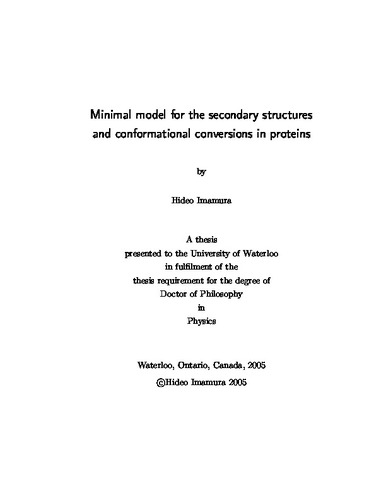UWSpace will be migrating to a new version of its software from July 29th to August 1st. UWSpace will be offline for all UW community members during this time.
Minimal model for the secondary structures and conformational conversions in proteins
| dc.contributor.author | Imamura, Hideo | en |
| dc.date.accessioned | 2006-08-22 14:37:36 (GMT) | |
| dc.date.available | 2006-08-22 14:37:36 (GMT) | |
| dc.date.issued | 2005 | en |
| dc.date.submitted | 2005 | en |
| dc.identifier.uri | http://hdl.handle.net/10012/1233 | |
| dc.description.abstract | Better understanding of protein folding process can provide physical insights on the function of proteins and makes it possible to benefit from genetic information accumulated so far. Protein folding process normally takes place in less than seconds but even seconds are beyond reach of current computational power for simulations on a system of all-atom detail. Hence, to model and explore protein folding process it is crucial to construct a proper model that can adequately describe the physical process and mechanism for the relevant time scale. We discuss the reduced off-lattice model that can express <em>α</em>-helix and <em>β</em>-hairpin conformations defined solely by a given sequence in order to investigate a protein folding mechanism of conformations such as a <em>β</em>-hairpin and also to investigate conformational conversions in proteins. The first two chapters introduce and review essential concepts in protein folding modelling physical interaction in proteins, various simple models, and also review computational methods, in particular, the Metropolis Monte Carlo method, its dynamic interpretation and thermodynamic Monte Carlo algorithms. Chapter 3 describes the minimalist model that represents both <em>α</em>-helix and <em>β</em>-sheet conformations using simple potentials. The native conformation can be specified by the sequence without particular conformational biases to a reference state. In Chapter 4, the model is used to investigate the folding mechanism of <em>β</em>-hairpins exhaustively using the dynamic Monte Carlo and a thermodynamic Monte Carlo method an effcient combination of the multicanonical Monte Carlo and the weighted histogram analysis method. We show that the major folding pathways and folding rate depend on the location of a hydrophobic. The conformational conversions between <em>α</em>-helix and <em>β</em>-sheet conformations are examined in Chapter 5 and 6. First, the conformational conversion due to mutation in a non-hydrophobic system and then the conformational conversion due to mutation with a hydrophobic pair at a different position at various temperatures are examined. | en |
| dc.format | application/pdf | en |
| dc.format.extent | 2830864 bytes | |
| dc.format.mimetype | application/pdf | |
| dc.language.iso | en | en |
| dc.publisher | University of Waterloo | en |
| dc.rights | Copyright: 2005, Imamura, Hideo. All rights reserved. | en |
| dc.subject | Physics & Astronomy | en |
| dc.subject | minimal model | en |
| dc.subject | protein | en |
| dc.subject | beta-hairpin | en |
| dc.subject | conformational conversion | en |
| dc.title | Minimal model for the secondary structures and conformational conversions in proteins | en |
| dc.type | Doctoral Thesis | en |
| dc.pending | false | en |
| uws-etd.degree.department | Physics | en |
| uws-etd.degree | Doctor of Philosophy | en |
| uws.typeOfResource | Text | en |
| uws.peerReviewStatus | Unreviewed | en |
| uws.scholarLevel | Graduate | en |

